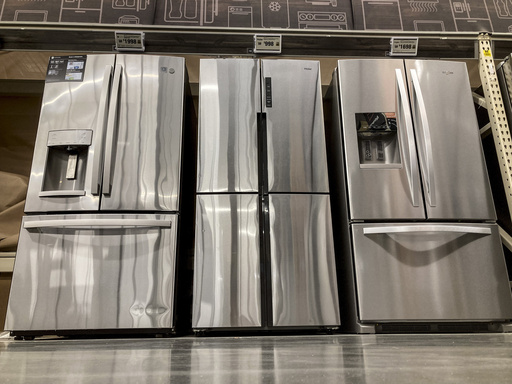NEW YORK (AP) — Americans pulled back their spending more than expected in January after the traditional holiday season splurge.
Retail sales fell 0.8% in January from the strong pace in December when they rose a revised 0.4%, according to the Commerce Department’s report on Thursday. Excluding sales at auto dealerships and gas stations, sales were down 0.5% for the month. The decline was bigger than the 0.10% drop that economists projected and marked the lowest monthly figure since March of last year.
Economists attributed part of the pullback to snowy weather conditions, but they also said the slowdown shows that shoppers may finally be buckling under higher interest rates and other financial hurdles and that the economic momentum from the end of 2023 could be starting to fade. Consumers account for roughly two-thirds of economic activity.
Excluding sales of autos, gas, building materials, and restaurant meals, the so-called control group of sales — used to calculate economic growth —fell 0.4% in January. Economists expected an increase.
The retail sales report could offer positive news that the Federal Reserve could finally start to cut rates, bringing relief to shoppers and businesses seeking lower rates for borrowing.
“Real consumption appears to have declined in January and, even allowing for a recovery over February and March, growth will slow sharply in the first quarter,” wrote Andrew Hunter, deputy chief U.S. economist at Capital Economics, in a report. “The upshot is that Fed officials may not need to worry much longer about the possibility of continued economic resilience reigniting inflation.”
Despite higher borrowing costs and elevated prices, household spending continues to be fueled by a strong jobs market and rising wages.
There was another surprising burst of hiring to start off 2024 as employers added 353,000 jobs in January, more evidence that the highest interest rates in two decades, intended to slow the economy, have yet to take hold.
But last month’s slowdown was widespread as shoppers cut back their spending in nine of 13 categories including clothing and accessory stores. Sales at building materials and garden suppliers fell a steep 4.1%, reflecting bad weather. Online sales fell 0.8%. But a solid gain at restaurants showed that spending at services remains sturdy, analysts said.
Consumer inflation in the United States cooled last month yet remained high, and the U.S. reported this week that consumer price index rose 0.3% from December to January. Compared with a year ago, prices are up 3.1%.
That’s far below the 9.1% inflation peak in mid-2022, but solidly above the Federal Reserve’s 2% target level at a time when public frustration with inflation has become a pivotal issue in President Joe Biden’s bid for re-election.
Starting next week, major retailers including Walmart and Macy’s are slated to report fiscal fourth-quarter results, which includes the holiday period.
But weaker sales at some of the big food and beverage companies could forebode a slowdown in spending at stores.
Kraft Heinz reported on Tuesday that fourth-quarter sales slipped as some customers, pinched by a bout of inflation, traded down to cheaper brands or did not buy as much.
A number of food makers, citing inflation, have raised product prices and that has helped preserve profits. But that can come at a cost to sales as some customers look for bargains elsewhere.
Last week PepsiCo, which makes snacks and drinks, experienced a similar trade-off after multiple price hikes, and it posted a rare decline in revenue.
Bill Barton, CEO of Bob’s Discount Furniture, noted the chain of more than 170 stores has been the beneficiary of shoppers trading down from department stores to less expensive options. The starting price for bedroom sets at Bob’s is $999. Barton noted that the Manchester, Connecticut-based company is able to keep costs down by offering fewer choices than department stores but going deep in inventory.
But Barton said shoppers are still cautious about spending on big ticket items because of higher borrowing costs. And the still high mortgage rates for homes has also dampened furniture sales.
“The impact of rates coming down would definitely improve furniture sales,” he said. ”It would certainly be good for the furniture category to take some pressure off the consumer in multiple ways.”
One big bright spot has been the beauty sector, helped by post-pandemic splurges by shoppers looking to indulge themselves in self-care and grooming products.
E.L.F. Beauty raised its annual profit and sales outlook last week after the beauty company reported strong sales in the latest quarter that included the holiday season.
“We’ve long been bullish on beauty,” CEO Tarang P. Amin told The Associated Press. “It’s one of these great categories, where particularly with all the pent-up demand from the pandemic, people really expressed themselves.”
The government’s monthly retail sales report offers only a partial look at consumer spending; it doesn’t include many services, including health care, travel and hotel lodging.
______
AP Economics Writer Christopher Rugaber in Washington contributed to this report.
Follow Anne D’Innocenzio: http://twitter.com/ADInnocenzio
This website uses cookies so that we can provide you with the best user experience possible. Cookie information is stored in your browser and performs functions such as recognising you when you return to our website and helping our team to understand which sections of the website you find most interesting and useful.
